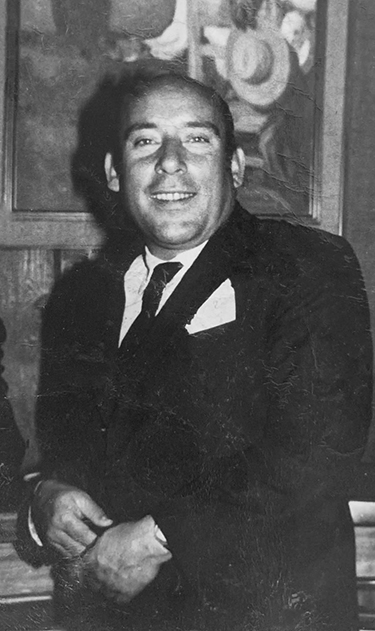It is impossible to dissociate the figure of Manuel Rodríguez Alba ‘El Brillantina’ (Chiclana de la Frontera, 1920 – La Línea de la Concepción, 1970) from the emblematic figure of Lola Flores, in whose company he played during the golden years of ‘La Faraona’, as immortalized by Antonio Martínez Ares in one of his songs.
His artistic profile is that of a versatile figure, very typical of the time, who combined singing, dancing and humour: legend has it that the well-known skit by ‘Chiquito de la Calzada’ with his hand holding his side was inspired by an occasion when ‘El Brillantina’ went on stage in great pain due to kidney stones, causing hilarity in the audience. Nano de Jerez also performed one of his best-known numbers, El Bombero.
Born on Fierro Street in Chiclana, he had to overcome his parents’ opposition to his dedication to the life of an artist. He began to participate in festivals and to frequent nightclubs and venues where his grace and self-confidence were all the rage. At the age of 20, he performed at the tablao Las Cuevas de Nemesio. At different times, he participated in flamenco groups at Las Cuevas de Nerja, Los Canasteros and Torres Bermejas, iconic tablaos in Madrid.
After a marriage that saw the birth of a son, ‘El Brillantina’ settled in La Línea de la Concepción, in whose municipal hospital he died at the early age of 50 as a result of a traffic accident after leaving one of his performances at the El Berrenchina venue.
He shone in cante por fiestas and was a supporting artist in the shows of the great performers of the time, such as Manolo Caracol, Lola Flores, whom he imitated, Roque Montoya ‘Jarrito’, etc. In Lola’s opinion, ‘El Brillantina’ was touched by grace, with a natural gift like ‘El Beni’ and many other artists of his time. The artist from Chiclana was genuine, warm and inimitable, leaving his mark on all who met him.
On 26 June 1960, he performed at La Perseverancia Bullring in Algeciras as part of an incredible artistic line-up, headed by Jarrito and Flores ‘El Gaditano’, including Rafael ‘El Tuerto’, Chato Méndez, Dominguillo, Pepe ‘El Sevillano’, and the Sánchez brothers and their father, Antonio Sánchez — in other words, Paco de Lucía with his family. His unique approach to the art of flamenco took him to legendary venues in Málaga, in Torremolinos and Marbella, such as La Pagoda Gitana and Tablao Ana María; in Córdoba, to El Brillante and El Jaleo; and in the town of La Línea, to El Boquerón de Plata and El Platero.
He was also cast in several film projects, including Una señora estupenda in 1967, a film by Eugenio Martin, featuring his friend Lola Flores, José Luis López Vázquez and Gracita Morales.
Although he settled in La Línea, he frequented Chiclana de la Frontera for the rest of his life, to visit his mother, fraternize with old friends such as Alonso Núñez ‘Rancapino’ and to frequent the tavern of Santa Mónica.
Beyond his musical legacy, which has not had a huge impact, he left behind a clear attitude towards life and flamenco as a witness and a protagonist during an unrepeatable era in which hunger hit him harder than the cockerel he played “matador” with some afternoons in the courtyard where he lived in La Línea.
